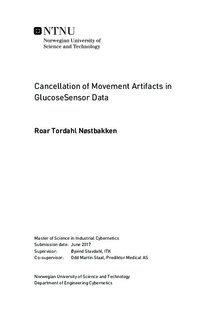Cancellation of Movement Artifacts in GlucoseSensor Data
Master thesis
Permanent lenke
http://hdl.handle.net/11250/2457154Utgivelsesdato
2017Metadata
Vis full innførselSamlinger
Sammendrag
The BioMKR wearable device developed by Prediktor Medical is aiming to be thefirst non-invasive continuous glucose monitoring device on the consumer market.The data gathered by the device, however, contains movement artifacts that limitits performance. The artifacts responsible for this deviation is believed to be correlatedwith the external forces acting on the device. Therefore, the use of a forcesensor as an auxiliary measurement is evaluated. A Force Sensing Resistor is integratedwith the BioMKR circuitry to enable stand-alone logging of data. The mainpurpose for this study is to evaluate the possibility of using the force measurementsto characterize the signal perturbations, and use the data set to compensate forfaulty readings.
This thesis evaluates the influence the external forces captured by the FSR sensorhas on the recorded near infrared signals. Two prototypes have been tested,where the second prototype needed additional improvement of the FSR actuatingsystem. Different adapters for the actuating system was developed, and their performanceare measured with respect to FSR signal stability, sensitivity and skinirritation. Test conducted with the prototypes replicate real use of the device, andconsists of strap test, night test, temperature test and external force test.
The results from night testing have been modeled using PLSR, which showedsome predictive properties. Building a model from one session and using it to predictthe FSR from another session proved unsuccessful, implying weak correlationbetween the FSR signal and NIR signal. The alteration of the optical propertiesof the tissue as a reponse to applied pressure is believed to affect the NIR signalsin a way that the FSR alone is not able to model.
Using the force signal as an event marker for NIR changes, however, proved tobe very good. It can be shown that the FSR successfully captures every significantNIR change as a result from involuntary movement during sleep.
It is advised that the force signal should be used together with accelerometerand other BioMKR parameters in determine the level of trust the resulting NIRsignal has in estimating the correct blood glucose. Further evaluation on filteringmethods to compensate for erroneous BioMKR data is also advised.
